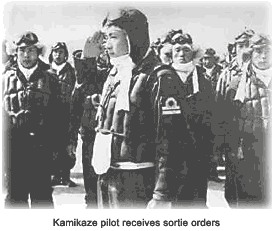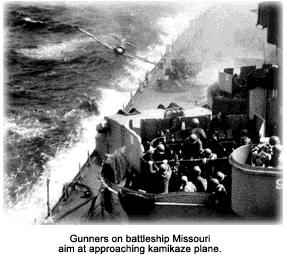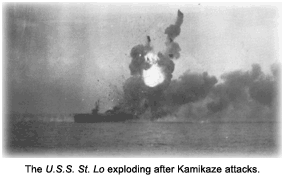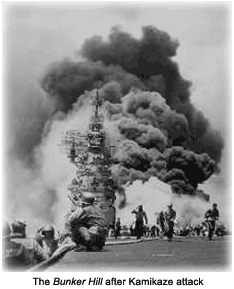Kamikaze
Transcend life and death. When you eliminate all thoughts about life and death, you will be able to totally disregard your earthly life. This will also enable you to concentrate your attention on eradicating the enemy with unwavering determination, meanwhile reinforcing your excellence in flight skills.
- A paragraph from the Kamikaze pilot's manual, located in their cockpits.
In the year 1281, Japan was under attack by a Mongol invasion — led by the powerful Kublai Khan. However, just as it appeared that the invading Mongols were about to overwhelm the Japanese, a catastrophic typhoon swept through the land, eliminating the entire Mongol army. From that point on, the typhoon that saved Japan became known as the Kamikaze or Divine Wind.
Background
After the defeat at the
Battle of Midway, and the fall of
Saipanin July 1944, the Japanese revived the name Kamikaze and ascribed it to the suicide missions of their air force.
Japanese Vice Admiral Takashiro Ohnishi, commander of the First Air Fleet in the Philippines, had noted that the most effective way to inflict damage upon Allied warships was to crash planes into them. He noted that one accidental crash could do more damage than 10 planes firing machine guns. It was decided then that pilots would purposely crash their planes — with half a ton of explosives — into American warships.
 The Kamikaze pilot
The Kamikaze pilot
Generally, Kamikaze pilots were university students motivated by obligation, and loyalty to family and country. A typical pilot was a science student in his twenties. He prepared for his fiery destiny by writing farewell letters and poems to loved ones, receiving a "thousand-stitch sash*," and by holding a ceremony — a drink of water that gave him a "spiritual lifting" before wedging himself between 550-pound bombs.
It was adamantly believed that, because they were fighting for their Emperor God, the Kamikaze would bring them deliverance at the darkest hour, just as it had in the 13th century. In fact, the call for Kamikaze pilots drew a staggering response. Three times as many applied for suicide flights as the number of planes available. Experienced pilots were turned down. They were needed to train the younger men how to fly to their deaths.
The fact that they were to go on suicide missions was accepted without question by the Japanese pilots. All inductees into the Japanese armed forces were indoctrinated with the following five-point oath:
A soldier must make loyalty his obligation.
A soldier must make propriety his way of life.
A soldier must highly esteem military valor.
A soldier must have a high regard for righteousness.
A soldier must live a simple life.
 The Mitsubishi A6M2
The Mitsubishi A6M2
Nicknamed the "Zero," the Mitsubishi A6M2 was the Kamikaze pilot's personal "flying coffin." It had a maximum speed of 332 mph and a range of 1,930 miles. The A6M2 was 29 feet nine inches long, with a wingspan of about 39 feet. The aircraft was armed with two machine guns and could carry 264 pounds of bombs; however, the Japanese modified its structure to accommodate a heavier arsenal. The Zero was the main strike aircraft used at
Pearl Harbor — dominating the skies during the early stages of
World War II. A large number were shot down during the Battle of Midway, and it eventually became outperformed by the latest allied aircraft, such as the P-51 Mustang.
First attacks
Beginning with the Pearl Harbor Attack, Japanese suicide bombers sporadically crashed their planes into the enemy as a spur-of-the-moment decision.
On October 21, 1944, the flagship of the Royal Australian Navy, the heavy cruiser HMAS
Australia, was hit by a Japanese plane carrying a 441-pound bomb, off
Leyte Island. Although the bomb did not explode, the damage was devastating — killing at least 30 crew members.

On October 25, the
Australia was hit again and was forced to retire to the New Hebrides for repairs. That same day, five Zeros attacked a U.S. escort carrier, the USS
St. Lo off the Philippines coast, although only one Kamikaze actually hit the ship. Its bomb caused massive fires that resulted in the ship's bomb magazine exploding, sinking the carrier. Japanese pilots also hit and damaged several other Allied ships.
The initial successes of those attacks sparked an immediate expansion of the program. During the next few months, more than 2,000 planes staged such attacks. Those included new types of suicide attacks and explosives, including purpose-built Yokosuka MXY7 Ohka rocket-bombs, small boats packed with explosives, and manned torpedoes (equipped with a 3000-pound warhead) called the Kaiten.
Iwo Jima and Okinawa
On February 19th, 1945, the USS
Enterprise and other carriers took up stations off
Iwo Jima, attacking nearby enemy airfields, and providing close air support for the
Marines that landed. By the time the marines unfurled the U.S. flag on Iwo Jima's summit, Kamikaze attacks had sunk the escort flattop
Bismarck Sea CVE-95, knocked the USS
Saratoga CV 3 out of the war for good, and temporarily halted the
Enterprise — all while regularly harassing amphibious forces at the beachhead.
The day of April 6th, 1945, proved to be most telling for the use of Kamikazes in the battle for
Okinawa. More than 350 aircraft at a time dove at the Allied fleet. Just the anticipation of Kamikaze attacks drove some American sailors literally insane. The destroyer
Laffey was attacked by 20 aircraft at once. Her gunners stopped nine Kamikazes, but six others rammed into the ship. As on the similarly damaged USS
Franklin, ineffable courage, and intensive training in firefighting, kept the
Laffey afloat.

On the 7th of April, Kamikazes were still attacking in great numbers off the coast of Okinawa, severely damaging the carrier
Hancock. By April 16th, suicide bombers desperately, but effectively damaged the USS Enterprise yet again, as well as the flattop USS
Intrepid, and numerous picket destroyers were sunk or damaged. Admiral Marc A. Mitscher led Task Force 58 from his flagship, the carrier
Bunker Hill CV-17. On May 11th, 1945,
the flagship was hit by a Kamikaze pilot that killed 350 of his men.
The final Japanese defense of
Okinawa was hard fought. For the Americans, victory brought a heavy price. The capture of Okinawa cost the Americans 49,000 in casualties, of whom 12,520 died. More than 110,000 Japanese were killed on the island. When it was clear that he had been defeated, General Mitsuru Ushijima committed ritual suicide (hara-kiri).
War's end
From October 25, 1944, to January 25, 1945, Kamikazes managed to sink two escort carriers and three destroyers. They also damaged 23 carriers, five battleships, nine cruisers, 23 destroyers and 27 other ships. American casualties amounted to 738 killed and another 1,300 wounded as the result of those attacks.
Several thousand Kamikaze planes had been set aside for an invasion of the Japanese mainland that never happened. Kamikaze pilots were one of the reasons President
Harry S. Truman decided to drop the
atomic bombs.
On the eve of the Japanese surrender, Takijiro Onishi ended his own life, leaving a note of apology to his dead pilots — their sacrifice had been in vain.
*A cloth belt into which 1,000 women had sewn one stitch as a symbolic union with a Kamikaze pilot.
 The Kamikaze pilot
Generally, Kamikaze pilots were university students motivated by obligation, and loyalty to family and country. A typical pilot was a science student in his twenties. He prepared for his fiery destiny by writing farewell letters and poems to loved ones, receiving a "thousand-stitch sash*," and by holding a ceremony — a drink of water that gave him a "spiritual lifting" before wedging himself between 550-pound bombs.
It was adamantly believed that, because they were fighting for their Emperor God, the Kamikaze would bring them deliverance at the darkest hour, just as it had in the 13th century. In fact, the call for Kamikaze pilots drew a staggering response. Three times as many applied for suicide flights as the number of planes available. Experienced pilots were turned down. They were needed to train the younger men how to fly to their deaths.
The fact that they were to go on suicide missions was accepted without question by the Japanese pilots. All inductees into the Japanese armed forces were indoctrinated with the following five-point oath:
The Kamikaze pilot
Generally, Kamikaze pilots were university students motivated by obligation, and loyalty to family and country. A typical pilot was a science student in his twenties. He prepared for his fiery destiny by writing farewell letters and poems to loved ones, receiving a "thousand-stitch sash*," and by holding a ceremony — a drink of water that gave him a "spiritual lifting" before wedging himself between 550-pound bombs.
It was adamantly believed that, because they were fighting for their Emperor God, the Kamikaze would bring them deliverance at the darkest hour, just as it had in the 13th century. In fact, the call for Kamikaze pilots drew a staggering response. Three times as many applied for suicide flights as the number of planes available. Experienced pilots were turned down. They were needed to train the younger men how to fly to their deaths.
The fact that they were to go on suicide missions was accepted without question by the Japanese pilots. All inductees into the Japanese armed forces were indoctrinated with the following five-point oath:
 The Mitsubishi A6M2
Nicknamed the "Zero," the Mitsubishi A6M2 was the Kamikaze pilot's personal "flying coffin." It had a maximum speed of 332 mph and a range of 1,930 miles. The A6M2 was 29 feet nine inches long, with a wingspan of about 39 feet. The aircraft was armed with two machine guns and could carry 264 pounds of bombs; however, the Japanese modified its structure to accommodate a heavier arsenal. The Zero was the main strike aircraft used at Pearl Harbor — dominating the skies during the early stages of World War II. A large number were shot down during the Battle of Midway, and it eventually became outperformed by the latest allied aircraft, such as the P-51 Mustang.
First attacks
Beginning with the Pearl Harbor Attack, Japanese suicide bombers sporadically crashed their planes into the enemy as a spur-of-the-moment decision.
On October 21, 1944, the flagship of the Royal Australian Navy, the heavy cruiser HMAS Australia, was hit by a Japanese plane carrying a 441-pound bomb, off Leyte Island. Although the bomb did not explode, the damage was devastating — killing at least 30 crew members.
The Mitsubishi A6M2
Nicknamed the "Zero," the Mitsubishi A6M2 was the Kamikaze pilot's personal "flying coffin." It had a maximum speed of 332 mph and a range of 1,930 miles. The A6M2 was 29 feet nine inches long, with a wingspan of about 39 feet. The aircraft was armed with two machine guns and could carry 264 pounds of bombs; however, the Japanese modified its structure to accommodate a heavier arsenal. The Zero was the main strike aircraft used at Pearl Harbor — dominating the skies during the early stages of World War II. A large number were shot down during the Battle of Midway, and it eventually became outperformed by the latest allied aircraft, such as the P-51 Mustang.
First attacks
Beginning with the Pearl Harbor Attack, Japanese suicide bombers sporadically crashed their planes into the enemy as a spur-of-the-moment decision.
On October 21, 1944, the flagship of the Royal Australian Navy, the heavy cruiser HMAS Australia, was hit by a Japanese plane carrying a 441-pound bomb, off Leyte Island. Although the bomb did not explode, the damage was devastating — killing at least 30 crew members.
 On October 25, the Australia was hit again and was forced to retire to the New Hebrides for repairs. That same day, five Zeros attacked a U.S. escort carrier, the USS St. Lo off the Philippines coast, although only one Kamikaze actually hit the ship. Its bomb caused massive fires that resulted in the ship's bomb magazine exploding, sinking the carrier. Japanese pilots also hit and damaged several other Allied ships.
The initial successes of those attacks sparked an immediate expansion of the program. During the next few months, more than 2,000 planes staged such attacks. Those included new types of suicide attacks and explosives, including purpose-built Yokosuka MXY7 Ohka rocket-bombs, small boats packed with explosives, and manned torpedoes (equipped with a 3000-pound warhead) called the Kaiten.
Iwo Jima and Okinawa
On February 19th, 1945, the USS Enterprise and other carriers took up stations off Iwo Jima, attacking nearby enemy airfields, and providing close air support for the Marines that landed. By the time the marines unfurled the U.S. flag on Iwo Jima's summit, Kamikaze attacks had sunk the escort flattop Bismarck Sea CVE-95, knocked the USS Saratoga CV 3 out of the war for good, and temporarily halted the Enterprise — all while regularly harassing amphibious forces at the beachhead.
The day of April 6th, 1945, proved to be most telling for the use of Kamikazes in the battle for Okinawa. More than 350 aircraft at a time dove at the Allied fleet. Just the anticipation of Kamikaze attacks drove some American sailors literally insane. The destroyer Laffey was attacked by 20 aircraft at once. Her gunners stopped nine Kamikazes, but six others rammed into the ship. As on the similarly damaged USS Franklin, ineffable courage, and intensive training in firefighting, kept the Laffey afloat.
On October 25, the Australia was hit again and was forced to retire to the New Hebrides for repairs. That same day, five Zeros attacked a U.S. escort carrier, the USS St. Lo off the Philippines coast, although only one Kamikaze actually hit the ship. Its bomb caused massive fires that resulted in the ship's bomb magazine exploding, sinking the carrier. Japanese pilots also hit and damaged several other Allied ships.
The initial successes of those attacks sparked an immediate expansion of the program. During the next few months, more than 2,000 planes staged such attacks. Those included new types of suicide attacks and explosives, including purpose-built Yokosuka MXY7 Ohka rocket-bombs, small boats packed with explosives, and manned torpedoes (equipped with a 3000-pound warhead) called the Kaiten.
Iwo Jima and Okinawa
On February 19th, 1945, the USS Enterprise and other carriers took up stations off Iwo Jima, attacking nearby enemy airfields, and providing close air support for the Marines that landed. By the time the marines unfurled the U.S. flag on Iwo Jima's summit, Kamikaze attacks had sunk the escort flattop Bismarck Sea CVE-95, knocked the USS Saratoga CV 3 out of the war for good, and temporarily halted the Enterprise — all while regularly harassing amphibious forces at the beachhead.
The day of April 6th, 1945, proved to be most telling for the use of Kamikazes in the battle for Okinawa. More than 350 aircraft at a time dove at the Allied fleet. Just the anticipation of Kamikaze attacks drove some American sailors literally insane. The destroyer Laffey was attacked by 20 aircraft at once. Her gunners stopped nine Kamikazes, but six others rammed into the ship. As on the similarly damaged USS Franklin, ineffable courage, and intensive training in firefighting, kept the Laffey afloat.
 On the 7th of April, Kamikazes were still attacking in great numbers off the coast of Okinawa, severely damaging the carrier Hancock. By April 16th, suicide bombers desperately, but effectively damaged the USS Enterprise yet again, as well as the flattop USS Intrepid, and numerous picket destroyers were sunk or damaged. Admiral Marc A. Mitscher led Task Force 58 from his flagship, the carrier Bunker Hill CV-17. On May 11th, 1945,
the flagship was hit by a Kamikaze pilot that killed 350 of his men.
The final Japanese defense of Okinawa was hard fought. For the Americans, victory brought a heavy price. The capture of Okinawa cost the Americans 49,000 in casualties, of whom 12,520 died. More than 110,000 Japanese were killed on the island. When it was clear that he had been defeated, General Mitsuru Ushijima committed ritual suicide (hara-kiri).
War's end
From October 25, 1944, to January 25, 1945, Kamikazes managed to sink two escort carriers and three destroyers. They also damaged 23 carriers, five battleships, nine cruisers, 23 destroyers and 27 other ships. American casualties amounted to 738 killed and another 1,300 wounded as the result of those attacks.
Several thousand Kamikaze planes had been set aside for an invasion of the Japanese mainland that never happened. Kamikaze pilots were one of the reasons President Harry S. Truman decided to drop the atomic bombs.
On the eve of the Japanese surrender, Takijiro Onishi ended his own life, leaving a note of apology to his dead pilots — their sacrifice had been in vain.
On the 7th of April, Kamikazes were still attacking in great numbers off the coast of Okinawa, severely damaging the carrier Hancock. By April 16th, suicide bombers desperately, but effectively damaged the USS Enterprise yet again, as well as the flattop USS Intrepid, and numerous picket destroyers were sunk or damaged. Admiral Marc A. Mitscher led Task Force 58 from his flagship, the carrier Bunker Hill CV-17. On May 11th, 1945,
the flagship was hit by a Kamikaze pilot that killed 350 of his men.
The final Japanese defense of Okinawa was hard fought. For the Americans, victory brought a heavy price. The capture of Okinawa cost the Americans 49,000 in casualties, of whom 12,520 died. More than 110,000 Japanese were killed on the island. When it was clear that he had been defeated, General Mitsuru Ushijima committed ritual suicide (hara-kiri).
War's end
From October 25, 1944, to January 25, 1945, Kamikazes managed to sink two escort carriers and three destroyers. They also damaged 23 carriers, five battleships, nine cruisers, 23 destroyers and 27 other ships. American casualties amounted to 738 killed and another 1,300 wounded as the result of those attacks.
Several thousand Kamikaze planes had been set aside for an invasion of the Japanese mainland that never happened. Kamikaze pilots were one of the reasons President Harry S. Truman decided to drop the atomic bombs.
On the eve of the Japanese surrender, Takijiro Onishi ended his own life, leaving a note of apology to his dead pilots — their sacrifice had been in vain.